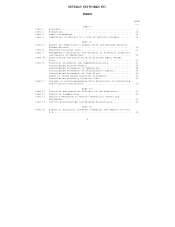8x8 2001 Annual Report Download - page 9
Download and view the complete annual report
Please find page 9 of the 2001 8x8 annual report below. You can navigate through the pages in the report by either clicking on the pages listed below, or by using the keyword search tool below to find specific information within the annual report.REFERENCE DESIGN KITS -- NME currently supplies the following reference design kits for its semiconductor products:
- The Media Hub MH2 reference design is a two-line, VoIP gateway based on the Audacity-T2 processor. It supports two analog telephone
interfaces, a 10/100 Mbps Ethernet port, and a simple LCD display.
- The IP phone reference design includes plastics, keypad, display, and handset and is based on the Audacity-T2 processor.
NME's reference design kits are intended to serve as prototype system products. The designs are intended to allow a customer to leverage
NME's system design expertise and accelerate its time to market with new products. Each reference design is provided with schematics, bills of
materials (BOMs), documentation, embedded software, and a software development environment that enables a customer to customize the
software and add new features.
VIDEOCONFERENCING SEMICONDUCTORS -- NME's family of videoconferencing semiconductors includes the VCP, LVP, VPIC, and
VCPex. These semiconductors are used in H.323, H.320, and H.324 videoconferencing applications including group videoconferencing
systems, personal computer (PC) videophone add-in boards, consumer videophones, and video monitoring systems. These semiconductors are
based on NME's proprietary architecture, which combines on a single chip a custom RISC microprocessor, a high performance DSP core,
SRAM, and proprietary software, which together perform the core processing functions required by LAN, ISDN, and POTS-based video
communication and other digital video applications.
HOSTED IPBX SOLUTIONS
The Company's subsidiary, Centile, is developing and marketing a hosted iPBX, a software-driven telephony solution that allows network
service providers and PBX resellers to offer PBX functionality as a business communication service over broadband IP networks. The
following sections describe Centile's technology and products more fully.
Technology
A business today requires an individual phone for each office worker, typically dozens for small and medium sized enterprises (SMEs). Until
recently, there were two ways that businesses could obtain this type of phone service:
subscribe to Centrex services from their local telephone company or buy a PBX system. In a Centrex service, the telephone company provides
a telephone line from its central office switch for each "extension" and associates all of the lines with a central number assigned to the business.
Centrex, however, scales poorly for both regulatory and architectural reasons. It is expensive on a per-line basis when compared to enterprise-
owned PBXs, which typically deliver additional functionality as well. In addition, Centrex services do not offer the ability for easy integration
with computer programs, require long lead times for moves, adds, and changes, and are difficult to manage.
Rather than subscribe to individual telephone lines for each employee (as with Centrex), most companies purchase a PBX system, a telephone
switch that allows dozens or hundreds of employees to share a few incoming and outgoing telephone lines, allowing efficient usage of those
lines. Traditional PBXs use circuit-switched technology and must be installed on the enterprise premise because every phone is connected to it
by an individual cable. These systems are expensive (from $20,000 to $200,000 or more, depending on the number of extensions), difficult to
manage, maintain, and use, and cannot be easily integrated with data processing systems.
With the availability of broadband IP connectivity to businesses, however, a third alternative has emerged: hosted iPBX services. In this model,
the service provider delivers PBX functionality over an IP connection, which reduces the scaling problems by allowing many extensions to
share a single connection. This solution also offers many of the advantages of an enterprise-owned PBX and further enables integration with
enterprise data processing systems and support of call centers, while eliminating the capital and maintenance investments required for a PBX.
5






















